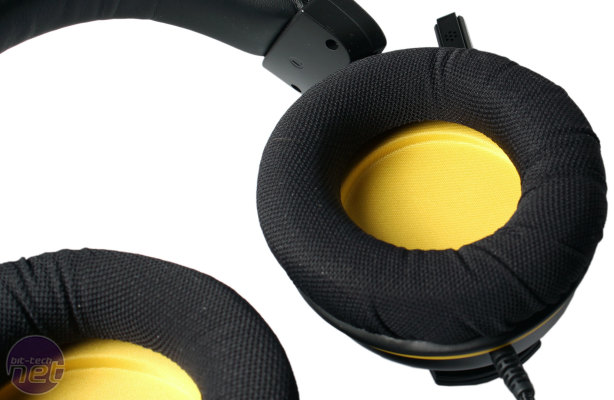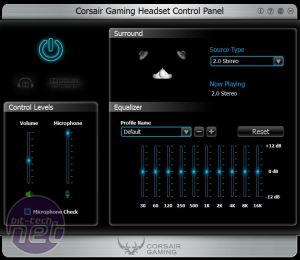
Software and Performance
The first thing we noticed about the H1500 is that it is a very loud headset. The in-line remote adjusts the Windows volume bar by 2 percent with each press, but even 10 percent volume we found to be enough for casual music listening, and our ears aren't particularly sensitive. At 20-30 percent we considered it to be loud, while over 50 percent it starts to become uncomfortably so and over 80 percent is almost unbearable. This isn't a bad thing, as it won't leave anyone wishing there was more volume on tap. However, the earcup material is quite breathable, and while this is certainly good for preventing overheating, it does mean that leakage from the headset is rather substantial at times. On the flip side, it's very hard to hear any external sounds once you have music playing or are in game.Test recordings using the microphone proved that, despite you not being able to bend it closer to your mouth, it's able to pick up your voice well and with clarity. It's also said to be noise-cancelling, and for the most part this worked well; nasal and oral breathing sounds only ever became an issue when we were deliberately loud, and when typing loudly on a mechanical keyboard we could still clearly make out our voice when whispering. However, the volume of the headset coupled with the leakage from the earcups means the microphone can be particularly sensitive to sound from the headset itself. Most headsets suffer this to some degree (and programs like Skype have automatic microphone sensitivity adjustment to help counter it), but it was particularly noticeable here.
As mentioned, you'll need Corsair's Gaming Headset software to take advantage of the surround sound features and to enable EQ adjustment. The software is very simple, both in terms of features as well as layout and ease of use. It offers level adjustments for the speakers and microphone, a power button to enable and disable the surround effects, basic surround sound control and an equaliser with numerous presets and the ability to create and save your own settings. Controlling the surround sound is as simple as selecting the appropriate sound source, which presumably alters the way the source is then up-converted to 7.1 surround using Dolby Pro Logic 11x (if you have the surround sound enabled and the source isn't already 7.1). The preset EQ levels include four 'Audiophile' ones, a reference EQ, two gaming ones (FPS and RTS) and a movie one.
Lows, mids and highs are all well represented by the 50mm drivers, with no one element suffering too badly from another being too dominant. However, though the bass is very much apparent, we did find that some songs lacked a bit of the punch we were used to from other headsets, almost sounding a bit hollow. Thankfully, enabling one of the Audiophile EQ settings fixed this for the most part. Our ears weren't able to tell the difference between the four different Audiophile settings (they're all very similar), but any one of them will help live up your music experience. The HyperX Cloud and Qpad QH-90 both just manage to win in this arena, thanks to warmer bass notes and even clearer and better defined mids and highs, but the H1500 still sounds good and is well balanced. It also has a lot more voume on tap if that's your thing.
The gaming and movie EQ settings were also both well suited to their respective media; Corsair has clearly done a good job in tweaking these to match the natural sound of the headset.
As for the surround effects, we much preferred to leave them disabled when listening to music. Too often, the 7.1 just sounded badly mixed, with some elements of songs too quiet and some too dominant – the regular stereo mode was fine, however. Conversely, we preferred to leave surround enabled when in movies and games. It's cliché to say, but in both instances we felt more surrounded by the sound reaching our ears, and the experience was more immersive as a result. In terms of picking out precise locations of things based on the sound they made, we didn't find the H1500 to be as effective as the Turtle Beach Z60 (which uses newer Dolby technology), and the sense of distance and scale also wasn't as good, but we enjoyed ourselves nonetheless. One thing we do think the H1500 is missing, however, is a button on the in-line remote to enable or disable the surround effects, as opening the software to do this every time might get annoying as you switch between music and games, for example.
Conclusion
The Corsair Gaming H1500 is another headset that ticks the important boxes of comfort, sound quality and ruggedness while retailing for a competitive price, as it can be found easily for £60. This puts it on par with the excellent Kingston HyperX Cloud, and at least £25 below the Turtle Beach Z60, which is fair considering the latter has improved surround sound effects. Compared to the Kingston, the Corsair isn't quite as well built or comfortable, and we prefer the sound of the Kingston's too – there's good reason they managed to earn a Premium Grade award. Nevertheless, the H1500 is far from lacking in any one of these areas, and it's also louder and introduces virtual surround sound too. With more connectivity options, the Kingston is also more versatile, but for a pure gaming headset, there are good reasons to go with Corsair.
-
Sound Quality36 / 40
-
Design25 / 30
-
Value25 / 30


MSI MPG Velox 100R Chassis Review
October 14 2021 | 15:04












Want to comment? Please log in.